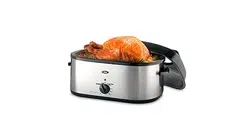Loading ...
Loading ...
Loading ...

www.oster.com
www.oster.com
8
9
2. Unwrap your frozen turkey and place it on the roasting rack inside
of roaster and place lid on top. Defrosting process begins.
• Make sure to have a good meat thermometer to check
defrosting temperatures from time to time; however, try not
to open the lid too many times as it is important to keep as
much heat as possible in the roaster while defrosting.
3. Check that legs and thighs have reached between 90°F and
100°F before basting. Once they do, brush the outside of the
turkey with butter or oil and season with salt and pepper (see
chart below for estimated times).
4. Continue cooking in the Defrost Setting until the thighs and
legs reach at least 130°F to 150°F and the breast reaches at least
50°F to 60°F. (see chart below for estimated times). Once
desired temperatures have been met, use a baster to remove
any excess liquid or ice chunks remaining in the cavity. Then,
using tongs, remove the bag of giblets and neck. Once
removed, brush the outside with additional butter or oil.
NOTE: If the giblets and neck are hard to remove at this time,
let the turkey defrost slightly longer checking about every 10
– 15 minutes until they can be removed relatively easily.
5. Now you are ready to start roasting. Turn the temperature
knob to 325°F and roast your turkey (see chart below for
estimated times). The turkey will be done roasting when the
temperature of the breast reaches at least 165°F and the legs
and thighs reach at least 175°F. The other important
temperature to take is inside the cavity - it also needs to
reach at least 165°F or you risk contaminating the rest of the
bird when you carve it.
NOTE: To check doneness of the turkey it is important to
take temperature readings in dierent areas of the turkey to
make sure it is all completely done. If any of the areas have
not reached the temperatures noted above, let it roast for a
little longer until they are reached, checking about every
10 - 15 minutes.
USING THE KEEP WARM SETTING
Your Oster
®
Roaster features a Keep Warm setting. The keep
warm setting is convenient for entertaining until you’re ready to
serve. When your food is done cooking, simply switch the
temperature dial to the keep warm setting and the roaster will
maintain a low heat to keep your food warm until you are ready serve.
ESTIMATED TIMES WHEN
USING DEFROST
Smaller Turkey
About 17Lbs.
Larger Turkey
about 23lbs.
Steps Hours Minutes Hours Minutes
Roaster Preheat (steps 1 & 2) 20 20
First Check of Temperatures (step 3) 1 30 4 30
Finish Defrosting (step 4) 2 1
Total DEFROST Time 3 50 5 50
Roasting Turkey (step 5) 2 1
Total DEFROST + ROAST Time 5 50 6 50
Above times are estimates and should be used as a guide to planning
your total time using the defrost setting. Your best indicators at each
stage are the temperatures the turkey reaches at each step using a
good meat thermometer.
NOTE: You might be wondering why it would take a smaller turkey
longer than a larger turkey to roast once it is thawed and you have
removed the neck and giblets. Your roaster defrost and roasting
process is based on temperature and turkey size.
• Larger turkeys – As the roaster is defrosting, it is also heating the
turkey; since it takes longer to defrost a larger sized turkey; it
also heats it longer therefore shortening the time to roast to
completion.
• Smaller turkeys – Since defrosting time for a smaller sized turkey
is shorter, so is the heating time of the turkey; therefore, it takes
longer to roast to completion.
Loading ...
Loading ...
Loading ...
